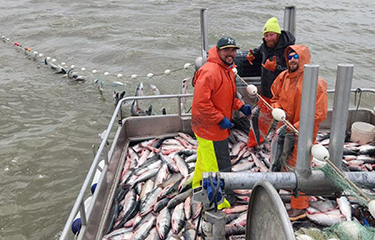The peak of Bristol Bay’s sockeye salmon run has past, and indications are the total catch will be lower than predicted.
Across Alaska, 42.3 million salmon of all types had been landed as of 13 July, according to the Alaska Department of Fish and Game. In Bristol Bay, ADF&G forecasted a run of 51 million sockeye in the Bristol Bay watershed in 2023, which would have made it one of the best years ever in the bay. But initial catch figures are coming up short of projections.
The first of the bay’s fisheries opened at the beginning of June, and as of 13 July, the baywide run had reached 24.5 million sockeye. AFF&G Fisheries Biologist Tim Sands, who manages the Nushagak and Togiak District fisheries in the western part of Bristol Bay, said 13.9 million of an expected run of 16.3 million salmon had already returned to those two rivers.
“I’m hopeful the total run will be 15 million to 16 million,” he told KLDG. “Obviously, more than that would be great, but I think we’ll be very close to forecasts.”
In the Nushagak, the total catch reached 9.5 million sockeye on Wednesday, 12 July, but the run is winding down, according to Sands.
Togiak has still not seen the bulk of its run come through, but Sands said it is also on track to meet its forecast.
“Catches seem maybe a little bit below average, but normal-ish,” Sands said.
Early catches were strong across Bristol Bay, but dipped recently, according to the University of Washington Fisheries Research Institute data.
“There have been really big drop-offs that seem just odd, and persist for a day or two or three,” Sands said. “I’ve heard rumors there are some fish coming in now, so maybe we’re having our last big push. We’ll hopefully trickle in a couple-hundred thousand here and there for a week or so and [see how] that adds up.”
The drop-offs are “not typical and very surprising,” Sands said.
“We’ll often have a lull for a day after a big blow, and we’ve had to close, but these lulls have lasted longer that I expected,” he said.
Despite the lower results, all rivers in Bristol Bay have reached their escapement goals, Sands said. And the sockeye that are returning are one year older and on average one pound heavier than previous years, he said, due to a large number of the salmon having spent an extra year at sea.
However, fishermen aren’t benefitting as much as they would from the fatter fish, as prices are down this year due to a glut caused by the record catch in 2022.
For king salmon and chum salmon in the Nushagak district, the runs have been “not good,” according to Sands. He said there’s hope the kings are just late, but it may be a smaller-than-expected run.
“We had really strong [king salmon] escapement in 2018, which was one of the main parent years for 2023, so I was optimistic,” he told the Alaska Journal of Commerce. “We’re not sure why we’re getting such poor production of kings. Something going on in the ocean, obviously it’s happening everywhere across the state.”
The king salmon run in the Kuskokwim River area is also trending below the preseason prediction of 142,000 fish, Sands told KTUU.
The Prince William Sound pink and chum salmon fishery is ramping up, registering 5.7 million pinks and 3.8 million chum caught to date.
Copper River sockeye landings have surpassed 700,000 fish and Alaska Peninsula sockeye landings have moved beyond 1.7 million fish, according to AFD&G data.
Photo courtesy of Bristol Bay Regional Seafood Development Association







